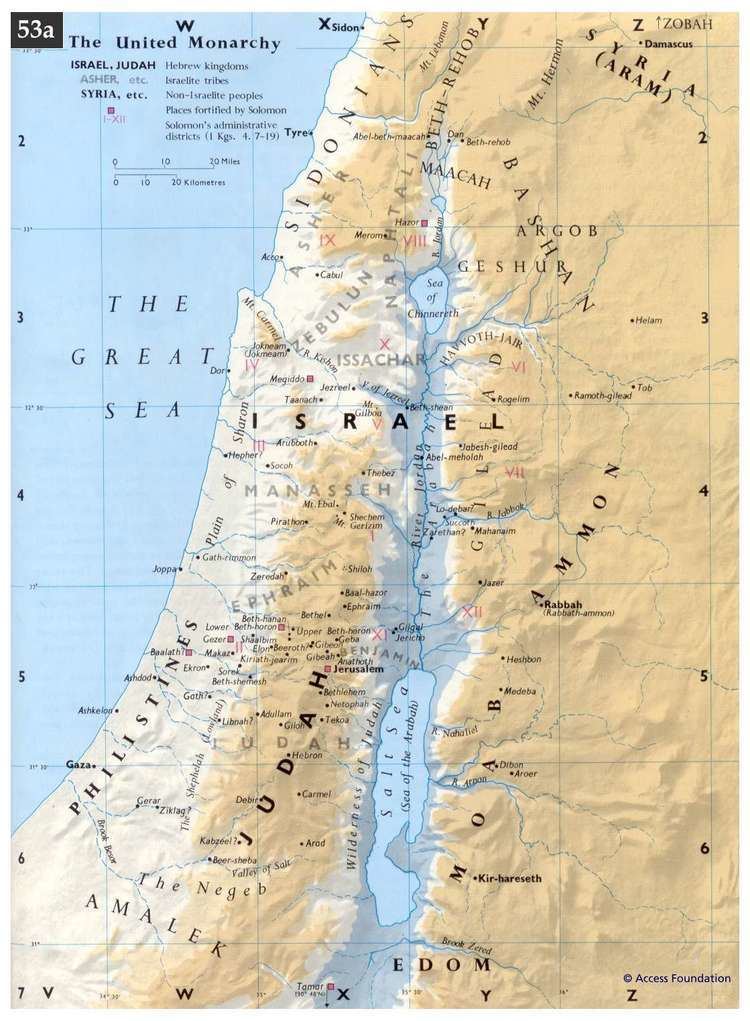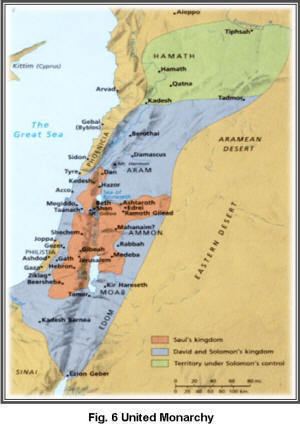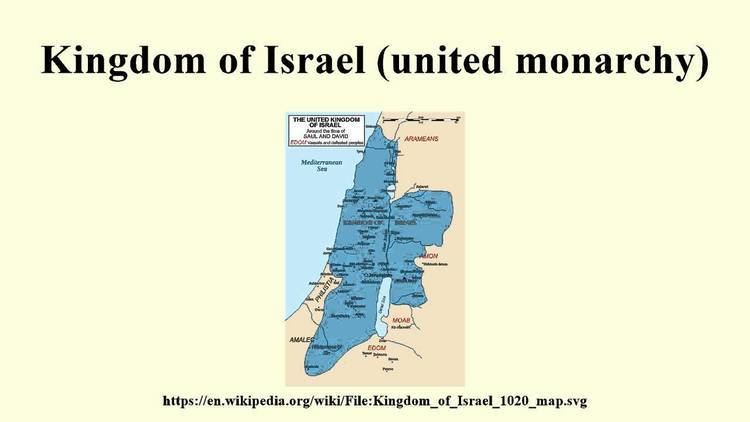Date dissolved 930 BC | Founded 1050 BC | |
 | ||
Government Monarchy, Hereditary Monarchy, absolute monarchy Similar Kingdom of Judah, Assyria, Galilee | ||
Kingdom of israel united monarchy
The United Monarchy is the name given to the Israelite Kingdom of Israel and Judah, during the reigns of Saul, David and Solomon, as depicted in the Hebrew Bible. This is traditionally dated between 1050 and 930 BCE. On the succession of Solomon's son, Rehoboam, in c. 930 BCE the biblical account reports that the country split into two kingdoms; the Kingdom of Israel (including the cities of Shechem and Samaria) in the north and the Kingdom of Judah (containing Jerusalem) in the south.
Contents
- Kingdom of israel united monarchy
- History
- Origin
- Civil war
- Golden Age
- End
- Chronology
- Archaeological record
- References

Modern historians are divided on the historicity of the United Monarchy as described in the Bible. There is no direct evidence of a united Kingdom of Judah and Israel in the 10th century BCE.

History

According to standard source criticism, a number of distinct source texts were spliced together to produce the current books of Samuel. The most prominent in the early parts of the first book are the pro-monarchical source and the anti-monarchical source. In identifying these two sources, two separate accounts can be reconstructed. The anti-monarchical source describes Samuel to have thoroughly routed the Philistines, yet begrudgingly accepting that the people demanded a ruler, and thus appointing Saul by cleromancy.

The pro-monarchical source describes the divinely appointed birth of Saul (a single word being changed by a later editor so that it referred to Samuel instead), and his later leading of an army to victory over the Ammonites, which resulted in the people clamouring for him to lead them against the Philistines, whereupon he is appointed king.

Textual critics also point to disparities in the account of David's rise to power as indicative of separate threads being merged later to create a golden age of a united monarchy. David is thought by scholars to have been a ruler in Judah while Israel, comparatively immense and highly developed, continued unfettered. Modern Archaeology also supports this view.

Most scholars believe the Books of Samuel exhibit too many anachronisms to have been a contemporary account. For example, there is mention of later armor (1 Samuel 17:4–7, 38–39; 25:13), use of camels (1 Samuel 30:17), cavalry (as distinct from chariotry) (1 Samuel 13:5, 2 Samuel 1:6), and iron picks and axes (as though they were common) (2 Samuel 12:31). The historicity of the conquest described in the Book of Samuel is not attested, and many scholars regard this conquest as legendary in origin, particularly given the lack of evidence for the battles described involving the destruction of the Canaanite peoples. Most scholars believe that Samuel was compiled in the 8th century BCE (rather than the 10th century where most of the events described take place) based on both historical and legendary sources, primarily serving to fill the gap in Israelite history after the events described in Deuteronomy. This gap in historical record is characteristic of the Late Bronze Age collapse; cultural memories of times before the disaster often became embellished as stories of a "lost golden age", e.g. the Trojan Epic Cycle.
Origin
According to the Book of Judges, the Israelite tribes previously lived as a confederation under ad hoc charismatic leaders called judges. Abimelech was the first to be declared king by the men of Shechem and the house of Millo, and reigned over Israel for three Years before he was killed during the Battle of Thebez.
According to the biblical account, the united monarchy was formed when there was a large popular expression in favour of introducing a king to rule over the previously decentralised Israelite tribal confederacy. Increasing pressure from the Philistines and other neighboring tribes is said by the Bible to have forced the Israelites to unite as a more singular state when Samuel anointed Saul from the tribe of Benjamin as the first king. The Bible treats the notion of kingship as having been an anathema at the time, it being seen as one man put in a position of reverence and power, which in their faith was reserved for God.
Civil war
According to the Second Book of Samuel, due to his disobedience to God, Saul's reign was curtailed and his kingdom given to another dynasty. The Masoretic Text says that Saul ruled for only two years. The Bible portrays Saul as having died in battle against the Philistines.
David and Saul had earlier become bitter enemies, at least from Saul's point of view, although the sources describe Jonathan, Saul's son, and Michal, Saul's daughter, as assisting David to escape Saul, ultimately leading to brief reconciliation before Saul's death.
Saul's heir, Ishbaal, took over rulership of Israel but, according to Samuel, ruled for only two years before he was assassinated. David, who had become king of Judah only, ended the conspiracy, and was appointed king of Israel in Ishbaal's place. A number of textual critics and biblical scholars have suggested that David was actually responsible for the assassination, and David's innocence was a later invention to legitimize his actions.
Israel rebels, according to Samuel, and appoints David's son Absalom as their new king. The Bible then describes Israel as taking over Judah and ultimately forcing David into exile east of the Jordan. According to the increasing majority of archaeologists, this isn't so much a case of rebellion by Israel against a mighty kingdom, but more a case of Israel re-asserting its authority over a poor, rural, sparsely populated, backwater.
This section of the biblical text, and the bulk of the remainder of the Books of Samuel, is thought by textual critics to belong to a single large source known as the Court History of David. Although reflecting the political bias of the later kingdom of Judah after Israel's destruction, the source is somewhat more neutral than the pro and anti monarchical sources that form earlier parts of the text. Israel and Judah are portrayed in this source as quite distinct kingdoms.
Eventually, according to the Book of Samuel, David launches a counter-attack, and wins, although with the loss of Absalom. After having retaken Judah, as well as asserted control over Israel, David returns to the west of the Jordan, although he continues to suffer a number of rebellions by Israel, successfully suppressing each one.
Golden Age
According to the biblical account, it was David who, following a civil war with Saul, created a strong and unified Israelite monarchy, reigning c. 1000–961 BCE. Solomon, David's successor, maintained the unified monarchy, c. 961–922.
David, the Second King of Israel, established Jerusalem as its national capital in 1006 BCE. Before then, Hebron had been the capital of David's Judah and Mahanaim of Ish-baal's Israel, and before that Gibeah had been the capital of the United Monarchy under Saul. Earlier parts of the Bible indicate that Shiloh had been seen as the national capital; which, from an archaeological standpoint, is considered plausible, as far as it being the religious capital.
In the biblical account, David finally succeeds in truly unifying Judah and Israel. Some modern archaeologists believe there was a continued and uninterrupted existence of two distinct cultures and geographic entities, one being Judah, the other Israel, and if there was a political union it possibly had no practical effect on the relationship between the two nations.
David embarked on successful military campaigns against Judah's and Israel's enemies, and defeated nearby regional entities such as the Philistines, thus creating secure borders. Israel grew from Kingdom to Empire, and its sphere of influence – militarily and politically – in the Middle East expanded greatly, controlling a number of weaker client states like Philistia, Moab, Edom and Ammon, with a number of Aramaean city-states (Aram-Zobah and Aram-Damascus) becoming vassal states; the imperial border stretched from the Mediterranean Sea to the Arabian Desert, from the Red Sea to the Euphrates River. Some modern archaeologists believe that the area under the control of Judah and Israel in this era, excluding the Phoenician territories on the shore of the Mediterranean, did not exceed 34,000 square kilometres (13,000 sq mi); of these, the kingdom of Israel encompassed about 24,000 square kilometres (9,300 sq mi).
David was succeeded on his death by his son, Solomon, who obtained the kingdom in a somewhat disreputable manner from the rival claimant, his elder brother Adonijah, whom he later had killed. Living up to his name (peace), the rule of Solomon was one in which the nation knew unprecedented peace.
Under Solomon, the United Monarchy experienced a period of peace and prosperity, and cultural development. Much public building took place, including the First Temple in Jerusalem.
David and Solomon are both portrayed by the Bible as having entered into strong alliances with the King of Tyre. In return for ceding land to Tyre, David and Solomon are said to have received a number of master craftsmen, skilled labourers, money, jewels, cedar, and other goods. David's Palace and Solomon's Temple are described as having been built with the assistance of these Tyrian assets, as well as to designs given by architects from Tyre.
Solomon is said to have rebuilt a number of major cities, including Megiddo, Hazor, and Gezer; these have been excavated and some scholars attributed elements of the archaeological remains, such as six chambered gates and ashlar palaces, to this building programme. However, later excavation teams at Meggido have made it clear that these structures are from different and later time periods. Yigael Yadin subsequently concluded that the stables that were once believed to have served the vast collection of horses that Solomon is believed to have kept, were actually built by King Ahab in the 9th century BCE.
End
Following Solomon's death in c. 926 BCE, tensions between the northern part of Israel containing the ten northern tribes, and the southern section dominated by Jerusalem and the southern tribes reached boiling point. When Solomon's successor Rehoboam dealt tactlessly with economic complaints of the northern tribes, in about 930 BCE (there are differences of opinion as to the actual year) the United Kingdom of Israel and Judah split into two kingdoms: the northern Kingdom of Israel, which included the cities of Shechem and Samaria, and the southern Kingdom of Judah, which contained Jerusalem; with most of the non-Israelite provinces achieving Independence.
The Kingdom of Israel (or Northern Kingdom, or Samaria) existed as an independent state until 722 BCE when it was conquered by the Assyrian Empire, while the Kingdom of Judah (or Southern Kingdom) existed as an independent state until 586 BCE when it was conquered by the Babylonian Empire.
Chronology
Many alternative chronologies have been suggested, and there is no ultimate consensus between the different factions and scholarly disciplines concerned with this period, as to when it began or when it ended.
Most historians follow either of the older chronologies established by William F. Albright or Edwin R. Thiele, or the newer chronology of Gershon Galil, all of which are shown below. All dates are BCE. Thiele's chronology generally corresponds with Galil's chronology below with a difference of at most one year.
Archaeological record
The question of the existence of archeological evidence for the united monarchy is debated in contemporary scholarship. It is generally accepted that a "House of David" existed but many believe that David could have only been the monarch or chieftain of Judah, and that the northern kingdom was a separate development. According to Israel Finkelstein and Neil Silberman, authors of The Bible Unearthed, the idea of a united monarchy is not accurate history but rather "creative expressions of a powerful religious reform movement," possibly "based on certain historical kernels." Although in a later book Finkelstein and Silberman do accept that David and Solomon were real Kings of Judah about the 10th century B.C, they cite that the earliest independent reference to the Kingdom of Israel is about 890 B.C, while for that of Judah is about 750 B.C. This is supported by Tubb, who argues that the United Monarchy is a created Golden Age written during the Exile. He accepts the historicity of David and Solomon but cautions that "They must be seen, however, as local folk heroes and not as rulers of international status."
Kuhrt reviews the general lack of archaeological evidence for the United Monarchy and concludes: "there are no royal inscriptions from the time of the United Monarchy (indeed very little written material altogether), and not a single contemporary reference to either David or Solomon.... Against this must be set the evidence for substantial development and growth at several sites, which is plausibly related to the tenth century." Kenneth Kitchen reaches a similar conclusion in his review of the evidence, arguing that "the physical archaeology of tenth-century Canaan is consistent with the former existence of a unified state on its terrain".
Excavations at Khirbet Qeiyafa, an Iron Age site located in Judah, found an urbanized settlement radio-carbon dated well before scholars such as Finklestein suggest urbanization began in Judah, supporting existence of a Judahite kingdom. The Israel Antiquities Authority stated: "The excavations at Khirbat Qeiyafa clearly reveal an urban society that existed in Judah already in the late eleventh century BCE. It can no longer be argued that the Kingdom of Judah developed only in the late eighth century BCE or at some other later date."
In August 2015, archaeologists from Israel unearthed extensive fortifications within the archaeological remains of Gath, traditionally considered the hometown of the biblical figure Goliath. These fortifications indicate that Gath was a significantly large city during the 10th century BCE, potentially the largest in the region of Canaan at that period. Aren Maeir, the professor overseeing the excavation, suggested that Gath might have been up to four times larger than Jerusalem at the time, raising questions about the historical magnitude of David's kingdom as portrayed in the Bible.
